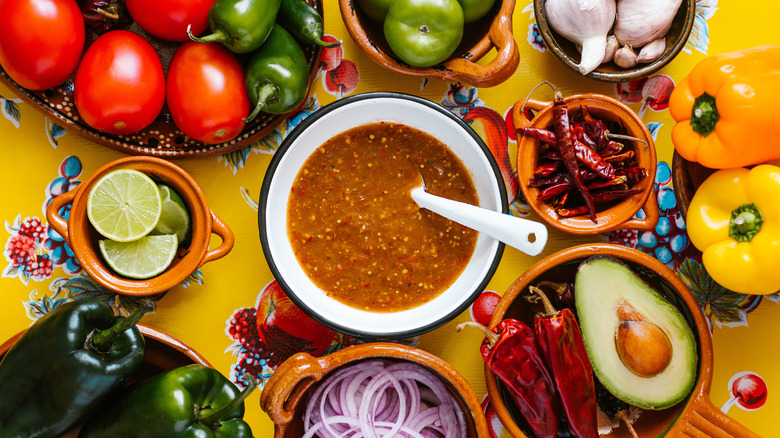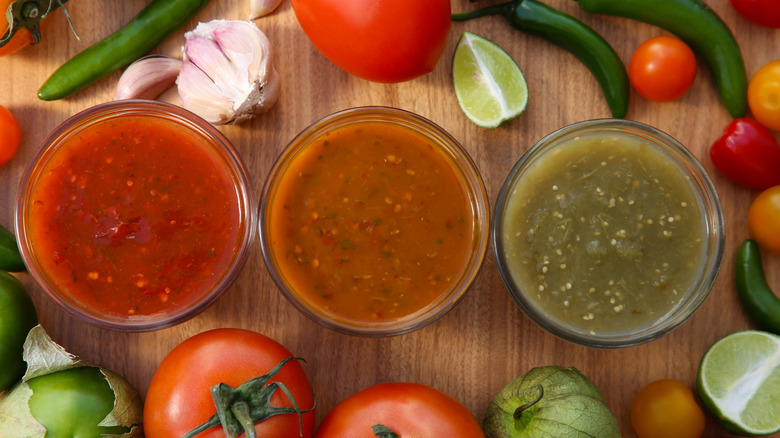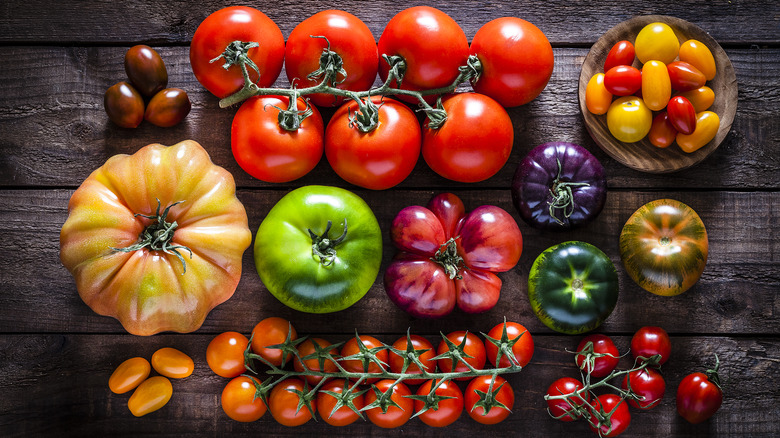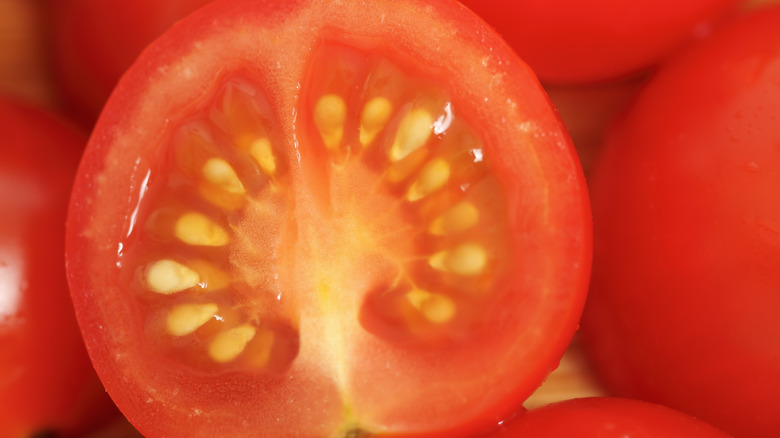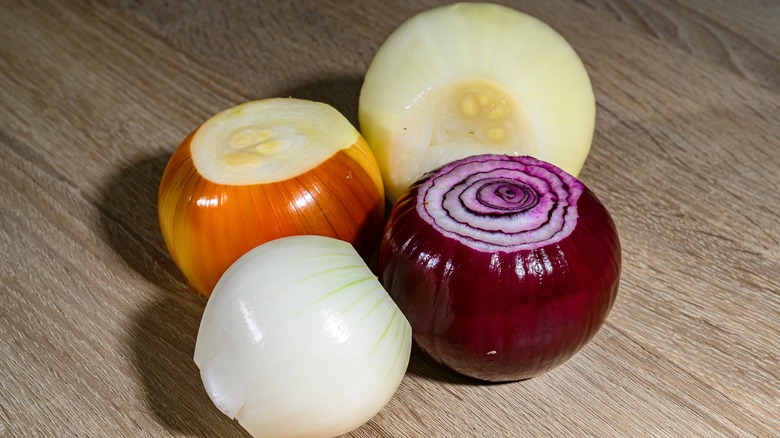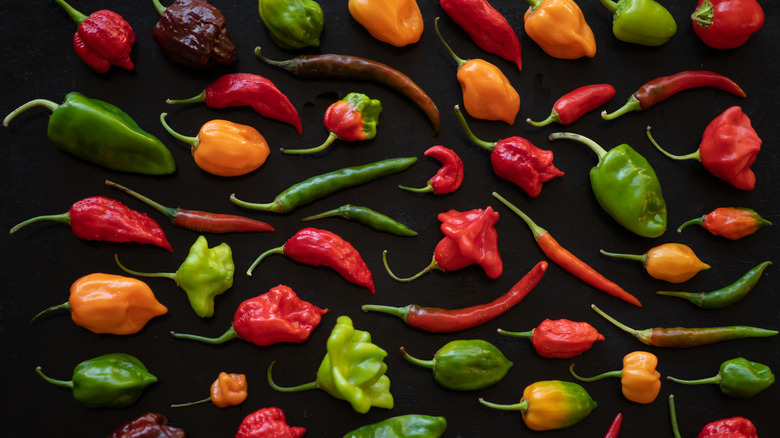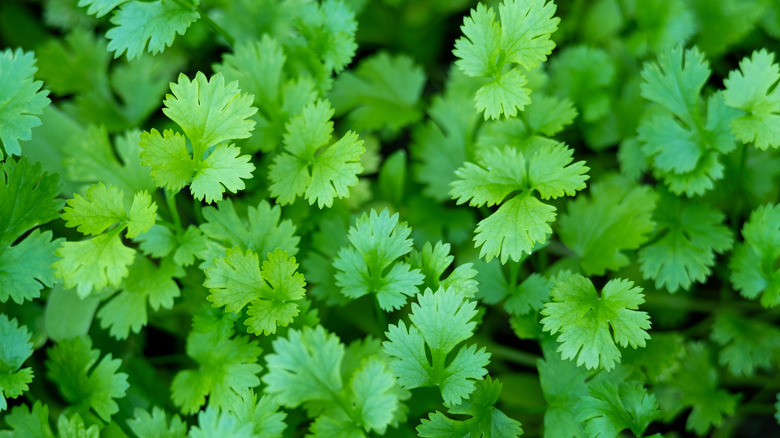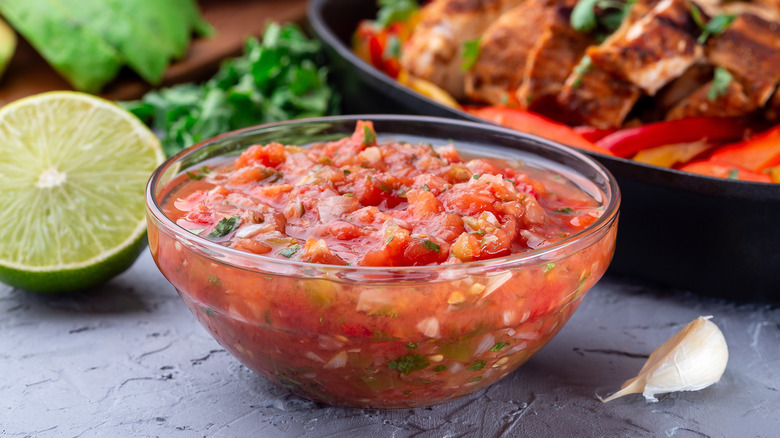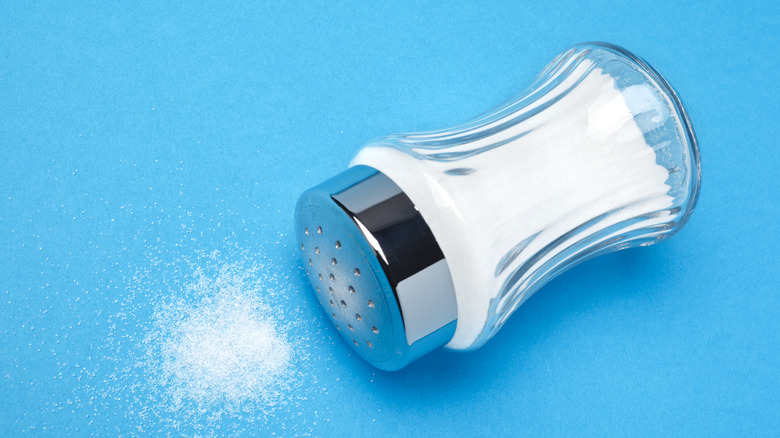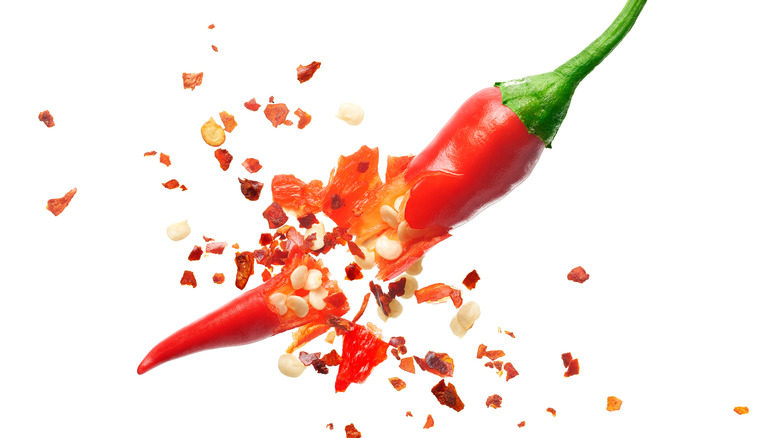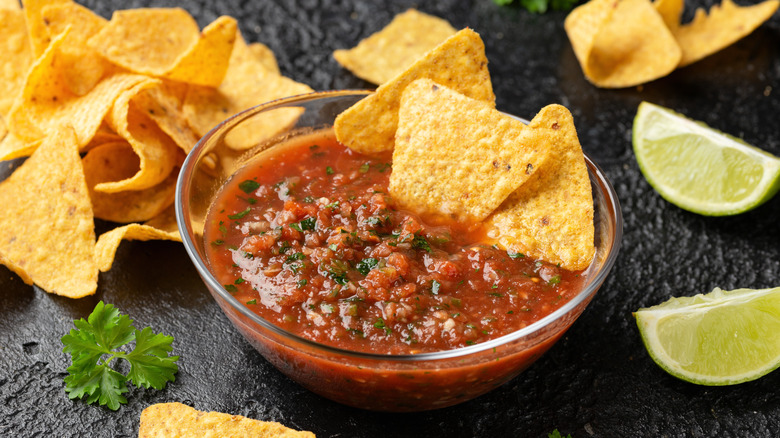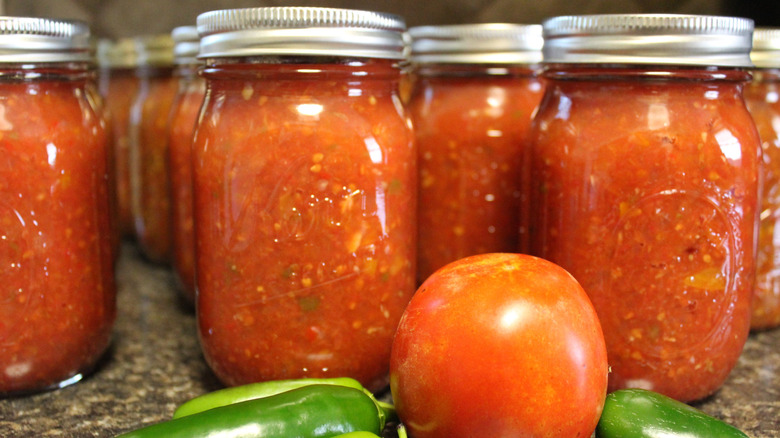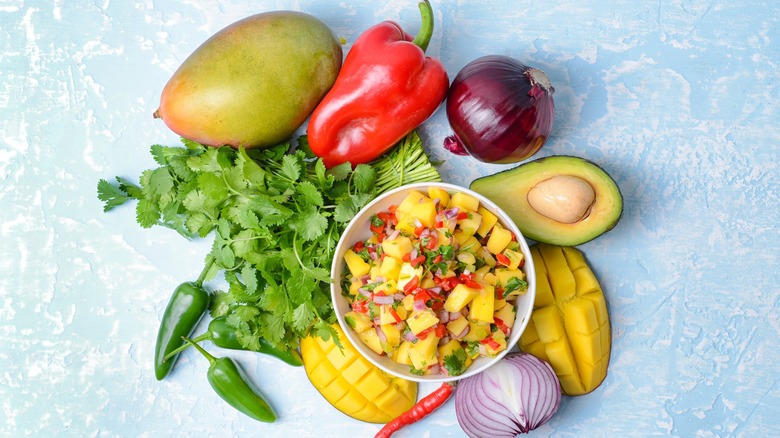12 Salsa Mistakes Everyone Makes
Move over ketchup, take a seat mayo, and step aside mustard. Another condiment is making waves in the U.S. — salsa. In 2013, salsa was reportedly America's number one condiment, and its popularity has increased even more over the following years. The public's love for Mexican food has hit an all-time high, from Mexican-inspired fast food joints like Taco Bell to sit-down restaurants to taco trucks, the south-of-the-border cuisine is here to stay. And one of the many things that make Mexican food a favorite is salsa.
Salsa is a hit because it adds fresh flavor and a little or a lot of spice. It's healthier than mayonnaise, has more tang than ketchup, and works better on a hot dog than mustard. Plus, it's inexpensive and easy to make. Every salsa lover has their own special recipe. Some salsas add tons of heat, while others keep it fresh with tomatoes and herbs. If you love salsa but are new to making it at home, you should know the mistakes everyone makes with it so you can avoid these common errors and make the best salsa every time.
Starting without a plan
When we talk about salsa, it's not just one thing — there are many types of salsa, from mild to spicy to chunky to blended restaurant style. So before you break out the cutting board, decide which kind of salsa you want to make. Start by thinking about how you want to use it. While there aren't any specific rules about salsa and food pairing, it depends mostly on personal taste and preference. All the same, there are a few general pairings. For example, pork is almost always paired with green salsa, beef is usually paired with a blended red salsa, and chicken and fish pair well with a chunky pico de gallo. But those are just guidelines. You can mix and match your salsa pairings to your tastes.
Next, you need to consider cooking methods. Fresh salsa, like pico de gallo, is made with raw ingredients. It has a crunchy texture and a toothy bite. Cooked salsa is made with boiled veggies, giving it a smoother taste without the sharpness of raw onion and crunch of fresh peppers. Roasted salsa is made by roasting the veggies until they're blackened, giving the salsa a rich, smoky flavor. So think about your main dishes and consider which salsa is going to complement them best.
Using the wrong type of tomatoes
Luckily, you don't have to wait for tomato season to make salsa, but you do need to consider which type of tomatoes to use for your favorite recipe. If you plan on slicing and dicing tomatoes to make a chunky pico de gallo, you should use a solid tomato like a beefsteak. These have firmer flesh and keep their shape well. If you are making a blended restaurant style, you can use Romas or canned whole tomatoes. For a smooth salsa and for a salsa that's not too chunky but not too smooth, mash the tomatoes by hand into the perfect texture.
The tomatillo, a small green fruit from the tomato family, is the star of green salsa. Make sure to remove the papery husk before adding them. And if you find yourself with some cherry or yellow pear tomatoes, blend them for a bright-colored smooth salsa or cut them in half for a chunky garden fresh salsa.
Leaving the tomato seeds in the salsa
To remove the seeds or not to remove the seeds is the question, and the answer is an ambiguous, "it depends." For some, leaving in the tomato seeds is fine for blended salsa because it adds texture, and removing them can be a pain. For others, the seeds should always be removed because they can be bitter, affecting the final taste. Specifically, tomato seeds are bitter when crushed; if they're left whole, then they're fine. When making salsa and combining ingredients though, even if you're careful, some seeds will get broken and crushed, altering the overall flavor.
Removing tomato seeds doesn't have to be a big chore. A simple way to get those seeds out is to cut them in half and use a spoon to scoop them out. You can save them to plant in your garden or just toss them into the compost bin.
Not knowing your onions
Onions aren't the star of salsa, but they are a key player, and not just any onion is right for the job. There are a few things you should know about onions before you decide which ones to add to your salsa. Yellow onions are the most common variety, and they're pretty versatile but best when cooked. These onions have a strong flavor, and cooking them tones down the intensity. If you're making roasted or cooked salsa and love the taste of onions, these will be a fine choice. If, on the other hand, you're making fresh, uncooked salsa, white onions are a better choice. White onions aren't as potent as yellow onions and are good in uncooked dishes.
Sweet onions like Vidalia and Maui are other favorite choices with a mildly sweet taste, and these are best raw. Red onions are mild and often also added raw to salads, burgers, and sandwiches. You can use these in fresh salsa for a milder flavor, but the best way to use red onions is to pickle them. You can make a quick pickled red onion for same-day use, or you can take more time to make lacto-fermented onions. Serve these alongside your favorite Mexican dishes right next to a delicious helping of salsa.
Picking the wrong peppers
Knowing the different types of peppers can help you make the right choice when choosing which to add to salsa. Spicy food isn't for everybody, and if you're making mild salsa, you don't want to accidentally add the wrong pepper. For mild salsa, bell peppers are great. They add a nice crunch to a garden-fresh salsa with zero heat. Jalapeño peppers, the most common type used in salsa, can be deceiving. They range from mild to medium hot. The best way to keep the heat at bay is to deseed them before adding them, but beware, as sometimes jalapeños have more of a bite than expected. Serranos are another small hot pepper and an excellent choice for salsa, resembling jalapeños while being hotter.
If you like spicy salsa, then chipotle peppers in adobo are an excellent choice. Chipotle peppers are just jalapeños that have been dried and smoked, so they bring the heat and also give a nice smoky flavor. Habanero peppers are small but mighty and pack a lot of heat. These can be green, orange, and red. The green ones are milder than the orange ones, and the red habaneros are the hottest.
Skipping fresh herbs for dry ones
One common mistake people make when making salsa is using dry herbs. It's an easy mistake because most home cooks have a cupboard full of dried herbs but may not have easy access to fresh ones, but using freshly cut herbs like cilantro and oregano makes a big difference to salsa. Fresh herbs just add that extra burst of flavor that dried herbs lack.
Cilantro is the most common herb to add to salsa, and luckily, it's inexpensive and widely available; when buying it, just be careful not to grab parsley accidentally. These two green herbs look similar and are often placed next to each other in the produce section. If you can't tell the difference between the two by just looking at them, give them a smell test and you can quickly figure out which is cilantro. Use the leaves in your salsa and save the cilantro stems for other dishes.
If you start making salsa and don't have any fresh herbs, you can still use dried ones. Of course, the salsa won't be as good but in a pinch, dried herbs can substitute. The ratio is key. Dried herbs have a more concentrated flavor, so remember to use less dry herbs than fresh ones.
Making it too watery
One thing that can ruin a good salsa is water. Watery salsa loses its flavor and becomes a bland version of itself. Extra moisture in your salsa from tomatoes or other ingredients can negatively affect the texture, too. Try dipping crispy tortilla chips into a watery salsa, and you'll likely find that all the flavor just slips right off.
The main culprit for watery salsa is tomato pulp. The membrane that holds the tomato seeds is a gelatinous, liquid substance that will quickly make a thick salsa too thin. This is especially true if the salsa is not consumed the same day it's made. Each day spent in the refrigerator will make it more watery. If you are already removing the seeds, you can easily remove the pulp, too. If you use canned tomatoes, drain the liquid and just use the tomatoes. If you add other canned ingredients like corn, jalapeños, or roasted red peppers, drain and dry them before mixing them into your salsa to avoid a soggy salsa.
To fix watery salsa, you can add a pinch of cornstarch. This is an easy way to thicken just about anything in the kitchen. Alternatively, you can add a spoonful or two of tomato paste to help the texture and flavor.
Over or under-salting
Everyone knows that salt is the base of every great dish, but for some home cooks, getting the right amount of salt can be tricky. Of course, if you undersalt your food, that's a simple fix — just add more salt. Going overboard with salt can be a more challenging mistake to fix, but luckily, there are a few ways to neutralize excess salt.
The tried and true fix to over-salted food is adding water, but in the case of salsa, that is not an option. While it's true that water will fix an oversalted soup or sauce, adding water to salsa will dilute the flavors and give an unpleasant texture. Luckily, there are other ways to fix over-salted salsa that won't affect the texture. The first is to add more acid. In the case of salsa, the best acid is fresh lime juice. In a pinch, you could substitute this with another citrus, like lemon or mandarin, but this may affect the final taste. Adding vinegar is another option for acid. Plain white vinegar can be overpowering, but if you stick to a splash of apple cider vinegar, it can do the trick. The second option to tone down the salt is adding a sweet element like a pinch of sugar or a drizzle of honey.
Having a heavy hand with the heat
Salsa is known for having some heat; even mild salsa brings a little tang. When making homemade salsa, though, it's easy to add too much spice. Using the wrong chili pepper, not deseeding the chilies, or just adding a pinch too much of dried chilies can make a salsa too hot. And, just like salt, it's hard to take it out once you add too much heat. So start slow with the heat — whether you add fresh peppers, chipotles in adobo, or splashes of tabasco or sriracha, go slow and taste as you go.
If you do go overboard with the heat, the best way to balance it out is to add more of the other ingredients and make a bigger batch than you originally planned. The more non-spicy other ingredients you add, the more you can tame the spiciness, so chop some more tomatoes and onions, or grab a few more cilantro leaves to try toning it down. If that doesn't work, you can always add something sweet, like honey, sugar, or agave syrup. Another tried and true way to bring down this is adding some dairy like Mexican crema or sour cream. For those who avoid dairy, a blended avocado works, too.
Serving without marinating it
One mistake to make is serving your salsa right when you finish making it. It's easy to understand because after chopping and blending, all of those savory smells start to make you hungry. But you should wait to serve that salsa so the flavors have a chance to mix for an overall better flavor. Salsa is a sauce, and all sauces taste better the next day. If you don't have the patience to wait a whole day, try to resist digging into that fresh batch of salsa for at least a few hours for the best flavor.
You may think it's fine to marinate your salsa on the counter because it's just vegetables, but the Center for Disease Control and Prevention recommends marinating in the refrigerator regardless of whether you are marinating meat or veggies because leaving any food on the counter, at room temperature, can cause bacterial growth. So seal up that salsa and place it in the refrigerator to marinate.
Not making enough to share
Everyone loves salsa, and it is the best part of going to a Mexican restaurant, diving into a pile of freshly fried tortilla chips and a bowl of tangy salsa. If you are going to make salsa, it's just as easy to make a lot. When making your next batch of salsa, double or even triple the recipe so you have some to give to your favorite salsa lovers. Fresh salsa will stay fresh for 5-7 days in the refrigerator. Grab some cute little jars and give salsa as a homemade birthday or holiday gift or just an everyday appreciation gift.
You can even try canning salsa at home using the water bath method, giving it a longer shelf life. If you plan on home-canning salsa, though, you can't use any old salsa recipe. You must use one of the eight approved salsa recipes from the National Center for Home Food Preservation to ensure your salsa has the right amount of acid and isn't susceptible to bacterial growth.
Making the same recipe every time
The biggest mistake everyone makes with salsa is sticking with the same recipe. You owe it to yourself to try all of the salsa. We understand when you find something you like, you stick with it, but in the case of salsa, it's worth branching out and trying some of the unique salsa recipes out there. If you like a sweet salsa that you can use on green salads or to accompany grilled fish, then mango salsa with bell peppers is perfect. If you like the sweet and hot combination, then pineapple habanero salsa is an excellent choice. But these recipes are not set in stone — you can substitute the sweet components for other fruits like pears, peaches, and even berries. You can also always play with the heat and try different peppers like pickled jalapeños or banana peppers.
Try making chunky salsa with heartier ingredients like corn kernels, black beans, or jicama. If you like textured salsa, try making salsa macha with dried chilies, roasted peanuts, and sesame seeds. In some regions of Mexico, salsa macha gets its unique texture from blended fried corn tortillas. For those salsa lovers who prefer blended salsas, try adding avocado, Mexican crema, or sour cream for a creamy salsa that is perfect on spicy enchiladas. The world of salsa is a great place to play with flavor, texture, and heat, so don't limit yourself and give every salsa a chance to become your new favorite.
